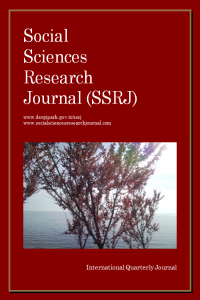Foreign Policy Understandings and Objectives of American Neo-Conservatives
Foreign Policy Understandings and Objectives of American Neo-Conservatives
The foreign policy of neo-conservatives, who are influential in determination of foreign policy of the USA, is not only a matter of wonder in the USA but has also been monitored by many countries with great interest. Especially, the neoconservatives, who are accepted as the architectures of the new era after the 11 September attack, have frequently been tried to be analysed either positively or negatively. The concepts such as “Cowboy Capitalism”, “Aggressive Foreign Policy” used to describe the foreign policy of the USA have been endeavoured to be unified with the understandings of Neo-Conservatives in a way; and have been attributed to them. By using some concepts attributed to Neo-Conservatives, the rivals have been tried to be weakened; and they have become the in home policy. In fact, the usage of such kinds of concepts generally does not mesh with the foreign policy understandings of Neo-Cons. Therefore, in this study, the content of Neo-Cons foreign policy understandings is tried to be discussed objectively.
Keywords:
The USA, Neo-Conservatives, Foreign Policy, Jewry Ex-Liberal,
___
- Ashford, N. (1983). Das Versagen des Staates. Der amerikanische Neokonservatismus. In: Fetscher, Iring (Hrsg.): Neokonservative und “Neue Rechte“. Der Angriff gegen Sozialstaat und liberale Demokratie in den Vereinigten Staaten, Westeuropa und derBundesrepublik. München, 35-65.
- Bader, T. (2005). Neokonservatismus, Think Tanks und New Imperialism. Witten, 11.
- Bemme, S. O. (2000). Ideologisierte amerikanische Innenpolitik an der Schwelle zum 21. Jahrhundert. O.O., 8.
- Deckert, N. (2004). Imperiale Ernüchterung. In: SWP Zeitschriftenschau. Januar 2004, 1-8.
- Fischer, P. (2012). Der amerikanische Neokonservatismus. KAS Auslandsinformationen 4/06. Im Internet:http://www.kas.de/wf/doc/kas_84 26-544-1-0.pdf?060512124951.
- Fukuyama, F. (2004). The Neoconservative Moment. In: The National Interest. Sommer 2004, 57-68.
- Gal, B.(2006)."The Neoconservative Persuasion: Examining the Jewish Roots of an Intellectual Movement”. Himmelfarb, D.(1988). Conservative Splits. In: Commentary. Mai, 54-58.
- Homolar-Riechmann, A. (2003). Pax Americana und gewaltsame Demokratisierung. Zu den politischen Vorstellungen neokonservativer Think Tanks. In: APUZ: B 46, 33-40.
- Hawley, C. (2006). "Die Neocons zogen die falschen Schlüsse. In SpiegelOnline.ImInternet:http://www.spie gel.de/politik/ausland/0,1518,407491,00. html (Stand:12.07.2012).
- Janssen, S. (2005). Ideologie und Praxis des Neokonservatismus. Zur theoretischen Basis US- amerikanischer Politik, 39 Im Internet:http://www.kas.de/wf/doc/kas_58 86-544-1-30.pdf(Stand:02.7.12)
- Kagan, R.(2003). Macht und Ohnmacht. Amerika und Europa in einer neuen Weltordnung. Berlin. Kristol,I. (1983). Reflections of a Neoconservative. New York .
- Kristol,I. (2003). The neoconservative Persuasion“,The weekly standard,Internet:http://www.weeklystand ard.com/Content/Public/Articles/000/000 003/000tzmlw.asp(Stand:09.07.12).
- Lind, M. (2004). "Es gibt keine" Die fingierte Selbstauflösung einer Ideologieschmiede., Blätter für deutsche & internationale Politik. Jahrgang, 427- 438.
- Podhoretz, N.(1996). Neoconservatism: A Eulogy. In: Commentary, 19- 27. Rudolf, P. (2005). George W. Bushs außenpolitische Strategie. SWP- Studie. Berlin. Im Internet: http://www.swpberlin.org/fileadmin/conte nts/products/studien/2005_S25_ rdf_ks.pdf (Stand:01.07.12).
- Rieger, F. (1989). Der amerikanische Neokonservatismus. Analyse und Kritik eines postliberalen Politikkonzepts, Wiesbaden, 5.
- Schissler, J.(1983). Neokonservatismus in den USA. Eine Herausforderung. O.O.,2.
- Siebo, M. H. J. (2005). Ideologie und Praxis des Neokonservatismus. Nr. 422 , 37-41
- Yayın Aralığı: Yılda 4 Sayı
- Yayıncı: Denta Florya ADSM Limited Company
